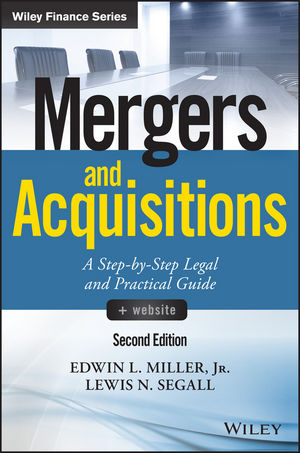
Mergers and Acquisitions: A Step-by-Step Legal and Practical Guide
Authors:
Edwin L. Miller, Jr. and Lewis N. Segall
Year:
2017
Month:
May
Publisher:
John Wiley
ISBN:
978-1119265412
Mergers and Acquisitions offers accessible step-by-step guidance through the M&A process to provide the legal and financial background required to navigate these deals successfully. From the initial engagement letter to the final acquisition agreement, this book delves into the mechanics of the process from beginning to end, favoring practical advice and actionable steps over theoretical concepts. Coverage includes deal structure, corporate structuring considerations, tax issues, public companies, leveraged buyouts, troubled businesses and more, with a uniquely solution-oriented approach to the M&A process. This updated second edition features new discussion on cross-border transactions and “pseudo” M&A deals, and the companion websites provides checklists and sample forms to facilitate organization and follow-through.
Mergers and acquisitions are complex, and problems can present themselves at each stage of the process; even if the deal doesn’t fall through, you may still come out with less than you bargained for. This book is a multi-disciplinary primer for anyone navigating an M&A, providing the legal, financial, and business advice that helps you swing the deal your way.
- Understand the legal mechanics of an M&A deal
- Navigate the process with step-by-step guidance
- Compare M&A structures, and the rationale behind each
- Solve common issues and avoid transactional missteps
Do you know what action to take when you receive an engagement letter, confidentiality agreement, or letter of intent? Do you know when to get the banker involved, and how? Simply assuming the everything will work out well guarantees that it will—for the other side. Don’t leave your M&A to chance; get the information and tools you need to get it done right. Mergers and Acquisitions guides you through the process step-by-step with expert insight and real-world advice.
Getting mergers and acquisitions transactions successfully completed requires an understanding of the legal framework, negotiating points, and practical aspects of each stage of the deal. M&As are complex undertakings with lots of moving parts and no end of tricky twists and turns at every stage of the process. This is why, no matter what your role in an M&A, it behooves you to learn as much as you can about their mechanics before entering into such arrangements—or you could come out of it with a lot less than you’d bargained for.
Fortunately, Mergers and Acquisitions, Second Edition makes it easier than ever for you to quickly get up to speed on all the M&A basics. Part legal primer, part business and negotiating how-to, it provides comprehensive, easy-to-digest insights, advice, and guidance for managers, investors, attorneys, and business professionals.
Attorneys Edwin Miller and Lewis Segall draw upon their decades of experience orchestrating M&As in both the public and private spheres to school you in the mechanics of M&As. Taking a multidisciplinary, solution-oriented approach, they walk you step by step through the entire process, filling you in on what you need to know about finance fundamentals, structuring transactions, tax considerations, leveraged buyouts, acquiring troubled businesses, and much more.
New to this edition of the critically acclaimed guide are discussions of cross-border transactions and quasi-M&A deals like joint ventures, and a companion website providing checklists and sample forms to facilitate organization and concrete understanding.
From the initial engagement letter to the final acquisition agreement, Mergers and Acquisitions, Second Edition arms you with the knowledge and tools you need to successfully navigate the M&A process and come out of it with everything you bargain for.
Table of Contents
Preface xi
Acknowledgments xv
CHAPTER 1 Structuring Fundamentals 1
Basic Corporate Finance Concepts 1
Reasons for Acquisitions 7
Three Basic Acquisition Structures 11
Structuring Considerations: Overview 14
CHAPTER 2 The Acquisition Process 20
Overview 20
Valuation of the Business 27
Investment Bank Engagement Letters 30
Confidentiality Agreements 35
Letters of Intent 37
Stay Bonuses and Other Employee Retention Arrangements 39
Business and Legal Due Diligence 42
Intellectual Property Due Diligence 55
From Signing to Closing 66
Appendixes 67
CHAPTER 3 Corporate (Nontax) Structuring Considerations 69
Business Objectives and Other Nontax Structuring Considerations 69
Acquisition Structure Diagrams 78
Forms of Acquisition Consideration 78
Debt 83
Cash, Stock, and Earnouts 96
Successor Liability and the De Facto Merger Doctrine 101
Securities Law Compliance 104
Antitrust Compliance: Hart-Scott-Rodino Act 114
Equity Compensation 120
Incentive Stock Options 126
Employment Agreements and Noncompetition Covenants 130
Indemnification 136
Employment and Benefits Law 138
Acquisition Accounting 140
Recapitalization Accounting 144
Appendixes 145
CHAPTER 4 Tax Considerations 146
Taxable Versus Tax-Free Transactions: Overview of Relevant Situations 146
Detailed Analysis of the Positions of the Target and Its Owners and of the Buyer 148
Taxable Transactions and Their Tax Effects 150
Tax-Free Transactions 154
Special Situations 159
Golden Parachute Tax 164
CHAPTER 5 The Definitive Acquisition Agreement 169
Economic Terms 169
Representations and Warranties 184
Covenants 196
Additional Agreements 199
Conditions to Closing 200
Survival of Representations and Indemnification 201
Termination 206
Miscellaneous 206
Representing Targets: A Summary 207
Appendixes 210
CHAPTER 6 Acquisitions of Public Companies 211
Public-to-Public Mergers: What is Different? 211
Case Law–Developed Fiduciary Duties and Standards of Review 214
Evolution of Fiduciary Duty Case Law and Judicial Review 220
Securities Laws and Public Company Acquisitions 237
Anti-Takeover Devices 247
Appendix 256
CHAPTER 7 Leveraged Buyouts (Structural and Tax Issues) and Acquisitions of a Troubled Business (Creditors’ Rights and Bankruptcy) 257
Leveraged Buyouts: Structural and Tax Issues 257
Acquisition of a Troubled Business Generally 263
Fraudulent Transfers 265
Acquisitions Out of Bankruptcy 272
CHAPTER 8 International M&A 282
Cross-Border Acquisitions 282
CHAPTER 9 Joint Ventures 292
Reasons for Joint Ventures 292
Types of Joint Ventures 293
Typical Joint Venture Terms 295
Appendix 304
About the Website 305
Index 307
Mergers and Acquisitions: A Step-by-Step Legal and Practical Guide
Edwin L. Miller, Jr. and Lewis N. Segall
John Wiley
Second
978-1119265412
